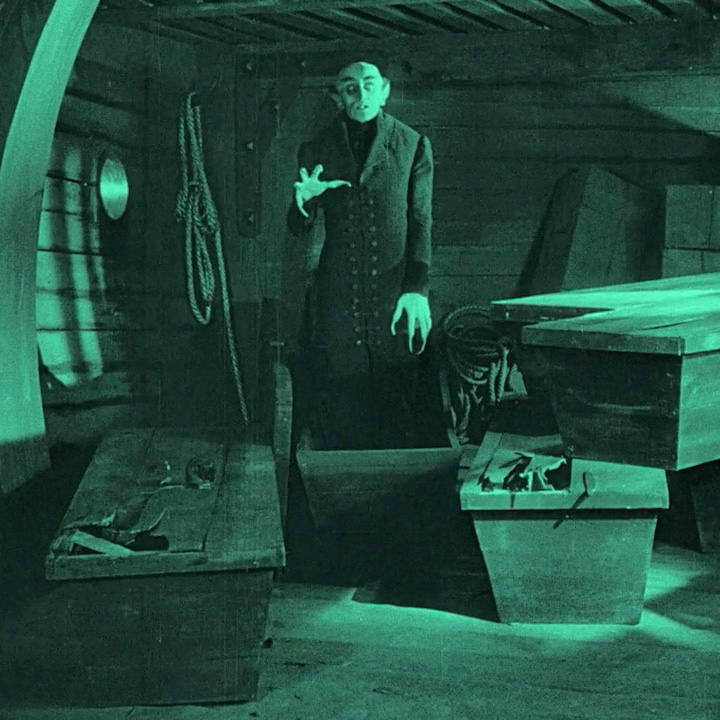Vampire movies come and go, but Nosferatu never dies. F. W. Murnau’s pirated adaptation of Bram Stoker’s Dracula, a visionary masterpiece of soul-blighting terror, broke new (burial) ground in 1922, hypnotizing audiences ever since with skin-pricking atmosphere and a nonpareil creep at its core.
The centenary celebration “Phantoms of the Night: 100 Years of Nosferatu”—opening on December 16 at the Staatliche Museen zu Berlin—traces the classic’s visual bloodlines backward and forward. It reveals how Murnau and company conjured a grisly-lyric dream state from real locations and diverse influences (Romantics, Symbolists, and cutting-edge graphic artists), galvanizing wide-screen fabulists such as Roman Polanski, Surrealist painters and writers such as Salvador Dalí and André Breton, and comic-book artists around the world.

The exhibit’s crucial revelation is the talent of Murnau’s producer-designer, Albin Grau. This painter-architect-occultist was key to transforming Stoker’s regal Dracula into the bestial Orlok, who oozes verminous carnality. Equal parts mesmerizing and repellent, Orlok has riveting black-rimmed eyes, and ears as long and pointy as his nails and fangs. Grau’s conceptual and promotional art features this spindly fiend looming over rats leaping from his coffin. He drew on the sinister, spidery work of Alfred Kubin—who illustrated Edgar Allan Poe and E. T. A. Hoffmann—and Hugo Steiner-Prag, best known for picturing a golem (a clay-made humanoid) as an ectomorphic wraith.
Murnau melded those models with his own. For a small German city circa 1838, he brewed a cozy Biedermeier atmosphere out of images such as Georg Friedrich Kersting’s The Elegant Reader. He based the look of Orlok’s bite victims on the tortured souls in a Goya print called Tantalo.

Max Schreck’s demonic performance as Count Orlok brought this painterly production to life, setting a standard of bold grotesquerie for future outsize actors. Willem Dafoe played Schreck, wittily and superbly, as a real-life vampire in the far-out, fictional making-of film Shadow of the Vampire (2000). Nicolas Cage, the Dracula in next year’s Renfield, channeled Schreck in the flamboyant black comedy Vampire’s Kiss (1988).
Current art-house darling Robert Eggers (The Witch, The Northman), the director of a forthcoming remake, has said that “in many ways” Nosferatu “invents horror movies.” It has left its mark on dozens of dark-side auteurs, including Werner Herzog, who directed a 1979 remake, and Guillermo del Toro, who dropped Orlok into a Simpsons Halloween episode. Murnau’s elongated shadows show up everywhere from Rouben Mamoulian’s Dr. Jekyll and Mr. Hyde (1931) to Pete Docter’s Monsters, Inc. (2001), and his ravenous Venus flytrap becomes Audrey Jr. in Roger Corman’s The Little Shop of Horrors (1960).
But this film’s legacy transcends horror or fantasy. Alfred Hitchcock observed Murnau in Berlin in 1924 and carried the master’s spellbinding chiaroscuro into his first thriller, The Lodger (1927). Ingmar Bergman, a huge Murnau fan, must have learned from Nosferatu how to charge movie trickery with emotion in The Magician (1958), Persona (1966), Hour of the Wolf (1968), and the nightmare in Wild Strawberries (1957).

Murnau treated vampirism as a trans-national threat—Orlok spreads plague with Transylvanian rats. So Nosferatu sowed the seeds of apocalyptic thrillers too, whether zombie jamborees such as Night of the Living Dead (1968) or medical nightmares such as Outbreak (1995) and Contagion (2011).
With purposeful, puckish showmanship, the museum has scheduled two Red Cross blood drives during the run of the exhibition. No one articulates the need for them better than Orlok’s insect-eating minion: “Blood is life,” screams the wretch. “Blood is life!”
“Phantoms of the Night: 100 Years of Nosferatu” will be on at Berlin’s National Gallery beginning December 16
Michael Sragow has been a film critic for Rolling Stone, Salon, and Film Comment, among other publications, and is the author of Victor Fleming: An American Movie Master


 Discover
Discover